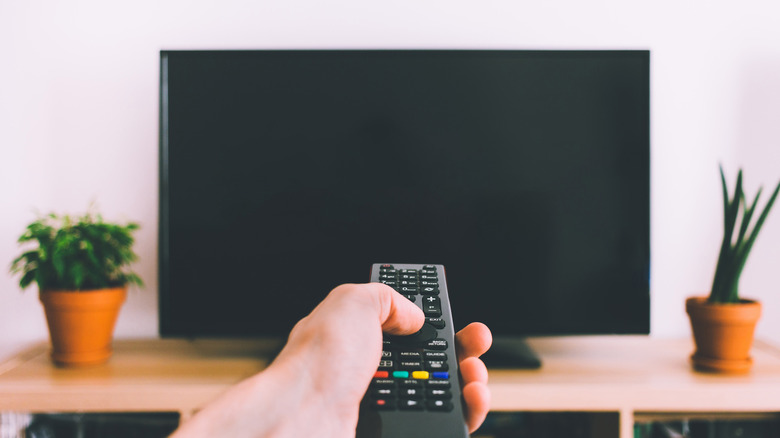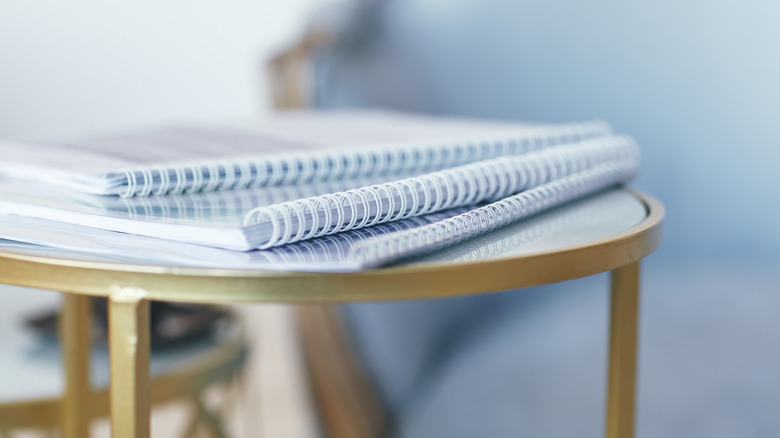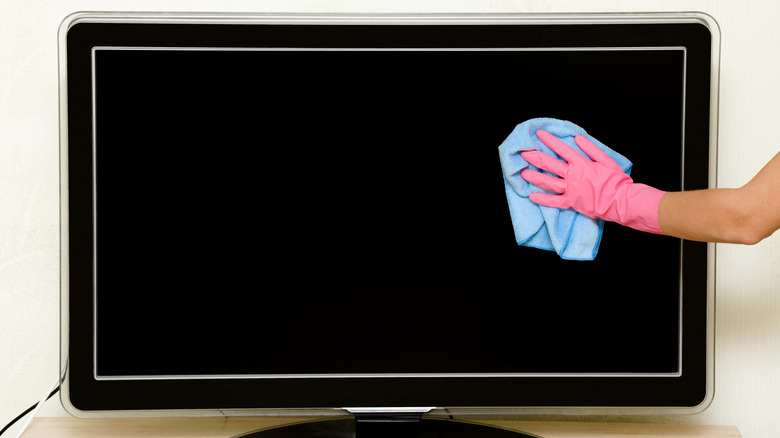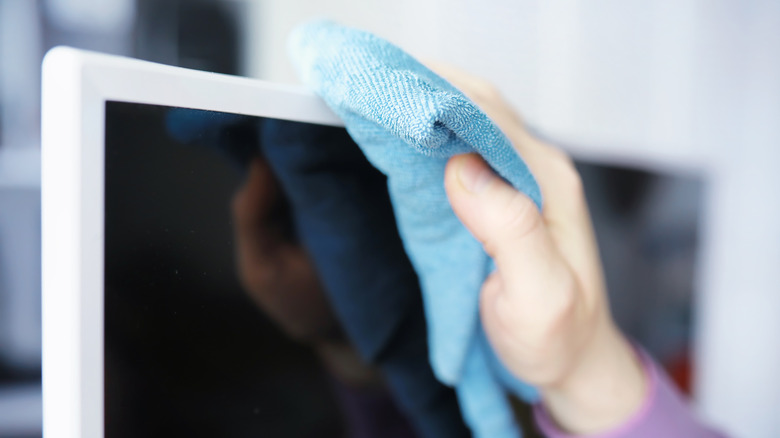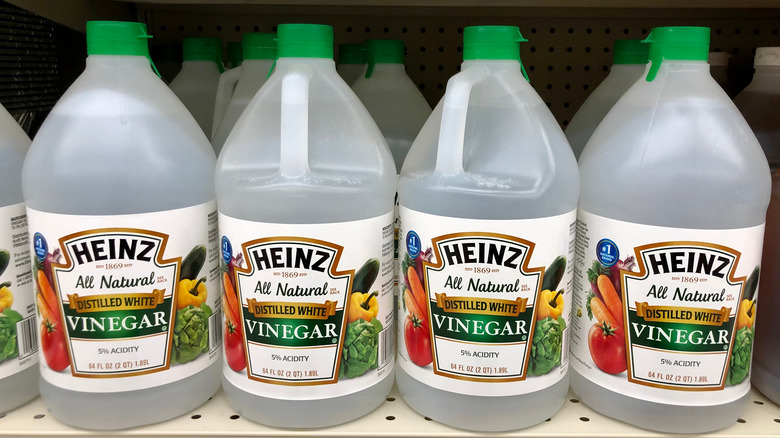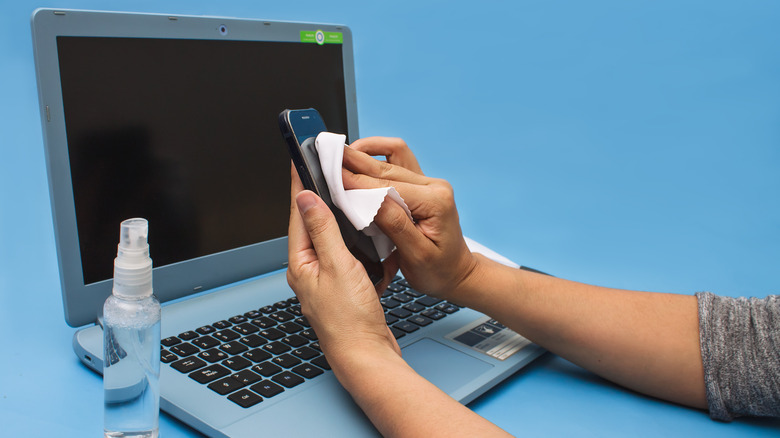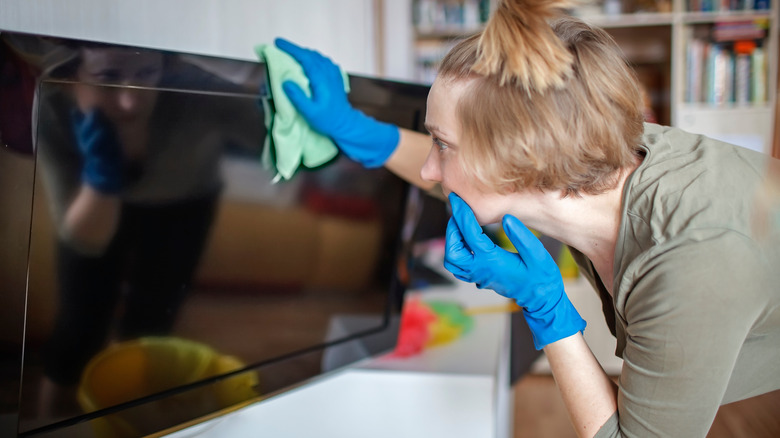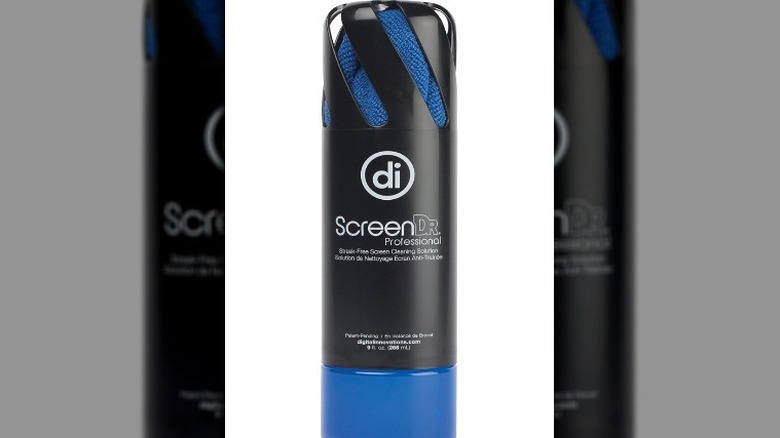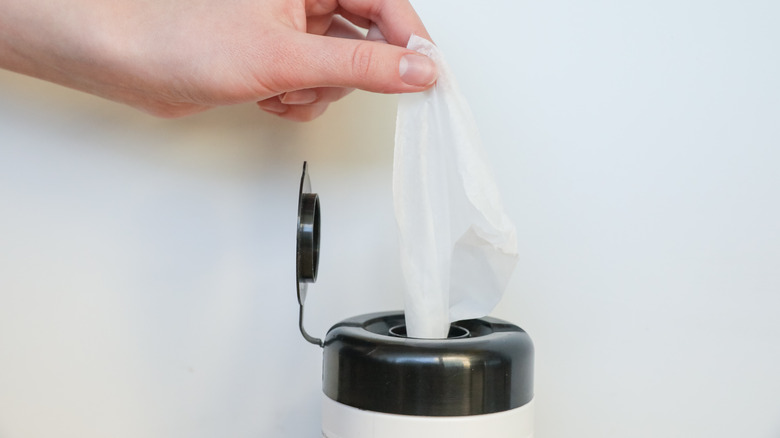8 Easy Ways To Clean Your Flat Screen TV Without Streaks
We may receive a commission on purchases made from links.
How do TVs get so gross? And we're not just talking about having kids and their inevitable little fingerprints all over the screen — flat screen TVs are just one of those things that you clean time and time again, but for whatever reason, they only look worse with each swipe of a cloth. They're a major dust magnet, prone to streaks, and a major frustration to clean. It's not like you're grabbing your TV hands-on 24-7 — duh, that's what a remote is for! — so what gives?
Whether you have an LCD or an OLED model, you've likely dealt with a few horrible streaks here and there (or honestly, all over) when you sit down to enjoy a night of Netflix and ice cream. As fabulous as these new, ultra HD or 4K TVs look with all the lights shut off, any tiny bit of glare is sure to shine a light on the streaks you've been dancing around for months. Don't press "power off" on tackling this problem just yet, though — we're here to break down how to clean your finicky flat screen of streaks for good. Here are the tools you'll need.
First check the manual
Before attempting to clean your TV, you should always take a quick peek at the instruction manual first. If you got rid of the manual or don't know where it is, a simple online search for the exact model should result in being able to easily download it.
There may very well be important information regarding what you should or should not be using to clean your specific flat screen TV. What can work for a QLED screen may not be the best for a LED, a plasma screen, and so on. So it's very important to know what the manufacturer instructions are ahead of using anything to clean the screen.
If you're thinking of skipping this step, you might want to reconsider. According to Better Homes & Gardens, if you attempt to use a product or process that isn't approved by the manufacturer, then it could make the TV's warranty invalid.
Turn the TV off before you clean
No matter the method you pick to tackle the streaks on your flat screen TV, this is a crucial step to avoid any streaks. If you use any sort of liquid, even just dampened on a gentle cloth, you're going to end up with a streaky cleaning job if you keep the TV on.
LCD screens produce heat when turned on. Even though it's a low level of heat that won't hurt you, cleaning a warm surface is a recipe for disaster — one wrong swipe or too much pressure in one area over another could leave a mark, and the added heat certainly won't help get rid of it. Regardless of whether your next step involves a DIY dish soap mixture or just plain old water, always make sure to unplug your TV and let the flat screen cool first to avoid a streaky finish.
1. Dust with a lint-free cloth
This may seem obvious, but it has to be said, since there's an expensive TV at stake here: Electronics and liquid don't play too well together. While there are some options that may help you get your screen streak-free, the best place to start is always with a dry, clean cloth.
Even if your TV looks like it needs some major TLC, a lint-free cloth (preferably microfiber) or feather duster may be just enough to do the trick. Whatever you do, definitely skip the paper towels, since those might scratch the surface — and the only thing worse than a streak on a TV is a permanent scratch.
Simply unplug the TV and give the screen a gentle wipe down. You don't want to apply too much pressure, because you'll risk damaging the hardware. Use just enough force to remove the dust and debris from the screen, and you should be left with a clean, streak-free result that's ready for your next binge-watching session.
2. Wipe away old streaks with a cloth and distilled water
If you've already attempted to clean your TV screen with some sort of cleaner, then there are probably some existing streaks you need to take care of. While a dry microfiber cloth is key to regular maintenance, it may not be powerful enough to remove any stubborn streaks from those previous misguided attempts at giving it a good clean. Luckily, you don't have to go too far — all you need is another cloth and some distilled water.
The key to a flawless flat screen is simple: Start with a dry microfiber cloth, wiping in gentle, circular motions. Then, spray another clean lint-free cloth with water. You don't want it to be oversaturated, and you definitely don't want to spray the water directly on the screen, since that could fry the internals of your TV. Get the cloth just damp enough and wipe the streaks away for good, then follow up with the dry cloth again to finish things off.
3. Make a spray with white vinegar and water
If water alone isn't cutting it, don't panic — and definitely don't grab just any of your nearest cleaning chemicals, either. Ammonia-based cleaners can wreak havoc on your flat screen TV. Ironically enough, people used to regularly use Windex to wipe down their old school TVs back in the day, but the popular window cleaner can actually degrade the protective layer of LCD flat screen TVs. Better to be safe than sorry!
Instead of harsh cleaners, mix up a 50-50 ratio of distilled water and white vinegar for a deeper clean. Combine the two in a spray bottle, then giving a spritz onto a lint-free cloth. Wipe down the flat screen in an S-shaped pattern to avoid any more streaks, then give it another pass with a dry cloth. This will stop the at-home vinegar mixture from sticking behind on the screen, and inevitably forming those unsightly water spots.
4. Use Isopropyl alcohol and an anti-static cloth
A tiny bit of isopropyl alcohol is about as harsh as you should get when it comes time to cleaning your flat screen TV, and that's saying something, considering it's not all that heavy-duty.
But if you're faced with some utterly annoying streaks front and center on your TV before the big game, this easy method may save your viewing party. Start with an equal amount of water and isopropyl alcohol and mix the two. Then apply it directly to an anti-static cloth. Be sure to wring out any excess liquid so that you aren't over-saturating the TV.
If that doesn't quite do the trick, it's safe to step up the game a bit and opt for 100% isopropyl alcohol instead — no water necessary to dilute it. It's a common fix for smudged device screens beyond just the TV: your phone, your laptop, you name it! Once you're done, give the TV another gentle wipe with the plain water to get rid of any residue from the alcohol, then dry it with a clean cloth. You should be ready to watch kickoff without a single streak in sight!
5. Try a small amount of dish soap
Believe it or not, but Panasonic, one of the most popular electronics companies out there, used to tout a very interesting recommendation for stuck-on streaks: dish soap.
The brand has said that the key to eliminating pesky streaks — after you've exhausted all other options — is a 100:1 ratio of water and dish soap. That means barely any soap at all, since the bubbles could get out of hand quickly, and leave you with a damaged device.
Always, always, always apply the cleaning solution to a gentle cloth first, then wipe down the screen. The last thing you want to do is spray the DIY cleaner onto the TV directly, since it's crucial that you control the amount of soap and water used. Double-check that the dish soap you're using does not contain ammonia or any abrasive chemicals or particles — if not, you should be in the clear to get cleaning.
6. Use an all-in-one cleaner kit (but be sure to check its ingredients!)
Another foolproof way to get your flat screen looking fresh out of the box again is to invest in a specialty cleaning kit. Most TV manufacturers don't recommend springing for harsh cleaners since they can damage the surface of LCD and OLED TVs, but some maintenance kits are created with those exact TV specs in mind.
ScreenDr is one popular choice among Amazon shoppers, averaging nearly five stars over almost 1,000 reviews. The kit costs just under $20 and comes with a soft microfiber cloth and designated TV screen cleaner. The cleaner is reportedly made from an "advanced, streak-free formula," and shoppers seem to support that claim. The only catch? It's probably still mostly water — most are 99% water since that's truly the best thing for the job.
If you spring for a different TV screen cleaner, always double-check the ingredients before applying. Benzene and acetone can permanently discolor your screen, which is substantially worse to deal with than the average smear or streak.
7. Break out an electrostatic duster
In lieu of a lint-free cloth, another simple method to try to clean your flat screen TV is using an electrostatic duster. Dusters are the next best alternative to microfiber cloths. Avoid using paper towels at any cost as they can leave lint behind on the screen (this is one of a few common mistakes you'll want to avoid while cleaning your TV).
Electrostatic dusters work the way they sound; they use static electricity to attract dust away from the surface and onto the duster instead. Using one on electronics, such as the TV, can be especially powerful in getting rid of the unwanted dust. Most are easy to wash by stirring the feathers in warm water and letting it dry.
If you don't currently have a specific electronic duster on hand, a Swiffer duster can serve as an excellent alternative. Be sure to avoid heavy pressure when using either type of duster on your TV screen. Just a light touch should do the trick.
8. Grab some electronic wipes
For a particularly tough-to-get-out spot on your flat screen TV, try using a wipe that is designed specifically to be safe for electronics. They're easy to find, particularly in any office supply or electronics stores, and easy to store in your TV console for easy reach.
They might not, however, be the best method for you if you own a plasma TV. Even though the screen is glass, there is an anti-glare layer that doesn't do well with wet cleaning products. They advise that you stick to dry methods such as a cloth or a duster to clean a plasma screen TV.
Electronic wipes are not only good for getting smudges off of your TV, but they are also safe to use on most other electronic devices that we touch often. Anything from our phones to our tablets can benefit from using wipes to keep them sanitized and clean.
